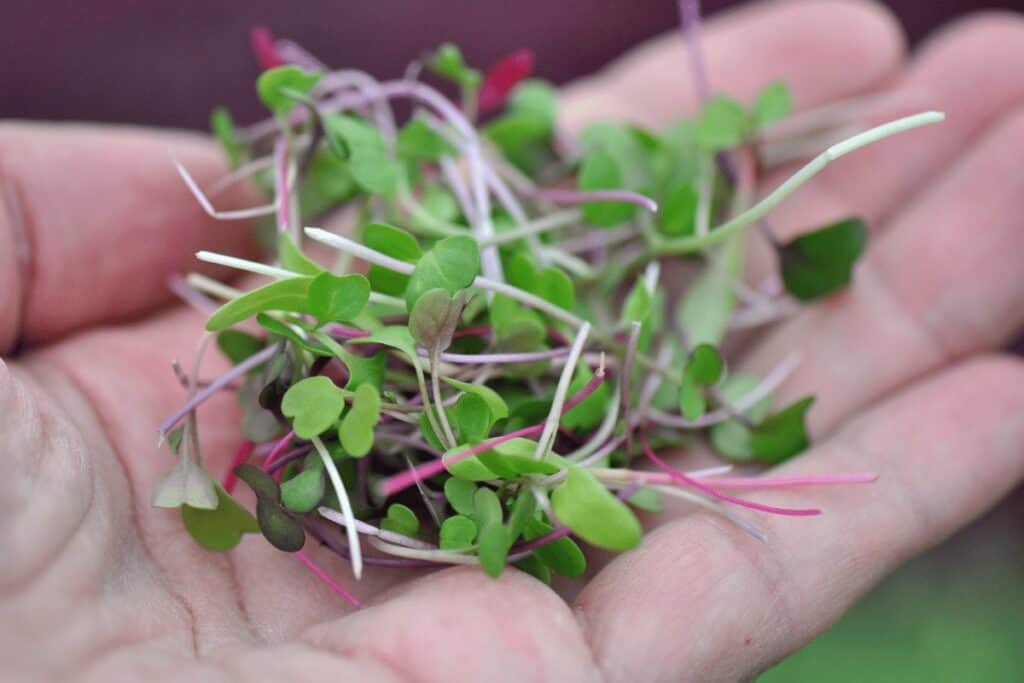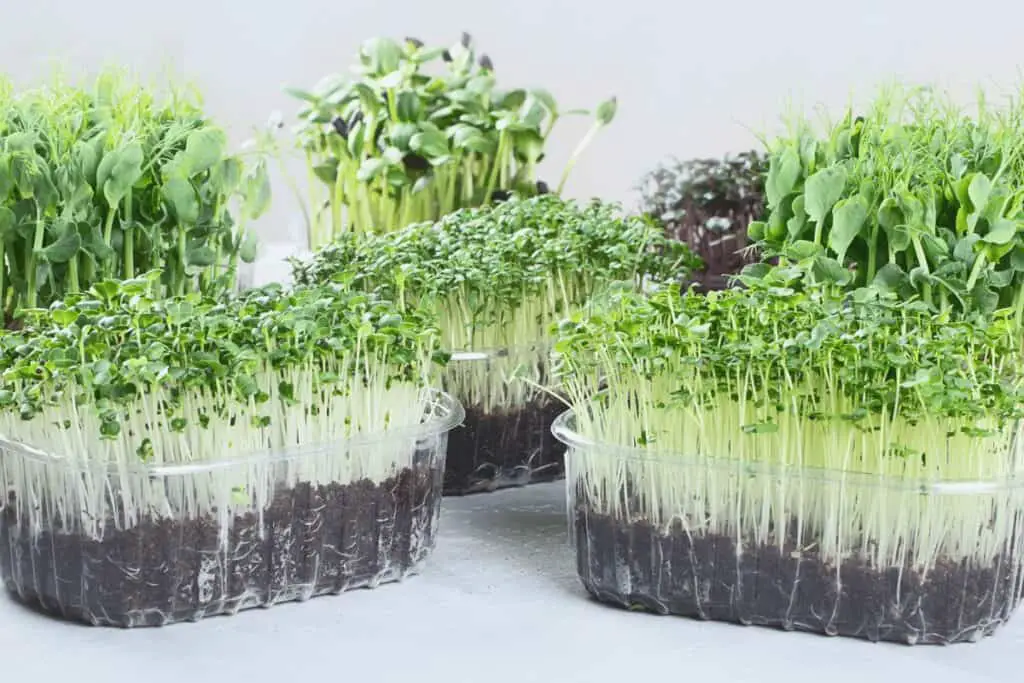Microgreens have gained immense popularity in recent years due to their concentrated nutrient content and vibrant flavors. Among the wide variety of microgreens available, broccoli microgreens stand out as a top choice for health-conscious individuals and culinary enthusiasts alike.
If you’re intrigued by the idea of growing these miniature powerhouses in the comfort of your home, you’re in for a treat. In this article, Broccoli Microgreens: A Nutrient-Packed Delight for Home Growing, we’ll explore the fascinating world of broccoli microgreens, learn how to grow them, and discover their incredible nutritional benefits.
Introduction to Broccoli Microgreens

Broccoli microgreens are essentially the young seedlings of broccoli plants, harvested when they reach a height of 2-3 inches (5-7.5 cm)[2]. These tiny greens possess a remarkable ability to pack an enormous nutritional punch within their delicate leaves. While any vegetable or herb can be grown as microgreens, broccoli microgreens have garnered significant attention for their distinct flavor profile and numerous health benefits.
What Makes Broccoli Microgreens Special?
The uniqueness of broccoli microgreens lies in their exceptional combination of flavor, nutrition, and ease of cultivation. These baby broccoli plants offer a concentrated burst of taste, resembling the essence of mature broccoli but with a milder and more tender profile.
Despite their small size, broccoli microgreens are packed full of nutrients, including vitamins A, C, and K, as well as essential minerals such as potassium and iron. They also contain an abundance of beneficial phytochemicals and antioxidants, known for their potential health-promoting properties.
Nutritional Benefits of Broccoli Microgreens
Broccoli microgreens are a nutritional powerhouse, offering a range of health benefits. These miniature greens are known to be rich in vitamins, minerals, and antioxidants that support overall well-being. Consuming broccoli microgreens may contribute to improved immune function, enhanced digestion, and even protection against certain chronic diseases[1][2].
The presence of sulforaphane, a compound found in broccoli microgreens, has been associated with potential anti-cancer properties, making these greens an excellent addition to a healthy diet.
Getting Started: Growing Broccoli Microgreens

If you’re eager to embark on your microgreen-growing journey, growing broccoli microgreens is a fantastic starting point. Here’s a step-by-step guide to help you cultivate these nutrient-dense delights:
Choosing the Right Seeds
Mumm’s Sprouting Seeds – Starter Sample Pack

625 GR – Organic Sprout Seed Kit – Broccoli, Radish, Alfalfa, Mung Bean
About this item
- MUMM’S THE WORD IN GROWING SPROUTS: Trust the sprouting experts when you’re looking for an easy sprouter kit. We’ve been producing certified non-GMO sprouting seeds on our organic farm since 1988. We’ll make your house herbaceous microgreen heaven!
- 6 POPULAR BLENDS IN 1: Spring Salad (broccoli, radish, red clover, and alfalfa), Ancient Eastern (fenugreek, lentils, kamut, adzuki), Crimson Lentils, Mung Beans, Broccoli Brassica (broccoli, broccoli raab, canola, radish, mustard, arugula), Alfalfa.
- GROW SUPERFOODS ON YOUR KITCHEN COUNTER: Grow nutritious sprouts in just a few days – even in the middle of winter! Sprouts are loaded with nutrients in ready-to-eat portions.
- BETTER THAN A MULTI-VITAMIN: You don’t need expensive supplements. Sprouts contain critical vitamins, minerals, antioxidants, fiber, and protein. Superboost your salads, sandwiches, stews, soups, and more!
- A PERFECT MATCH FOR BEAN SCREENS: Ordinary wide-mouth mason jars (not included) work fine, if you’ve invested in a screen lid system like Bean Screens by Masontops, with Mumm’s seeds you’ll grow the most delicious and nutritious sprouts around!
To begin, select high-quality broccoli microgreen seeds from a reputable source. Look for organic, non-GMO seeds specifically labeled for microgreen production. These seeds are specially bred to offer optimal taste and nutrition.
Preparing the Growing Medium
Next, prepare the growing medium for your microgreens. You can use various options such as soil, coconut coir, or specialized hydroponic mats. Ensure the medium is moist but not overly saturated to support healthy germination.
Planting and Germination
Spread the broccoli microgreen seeds evenly across the growing medium, ensuring they are not too densely packed. Lightly press the seeds into the medium and cover them with a thin layer of the growing medium or a humidity dome.
Place the tray or container in a warm, well-lit area, away from direct sunlight, and mist the seeds regularly to maintain moisture.
Care and Maintenance
As your broccoli microgreens begin to grow, continue providing them with adequate moisture and indirect light. Ensure proper airflow to prevent the development of mold or disease. Regularly check the moisture levels and adjust as necessary. Within a few days, you’ll witness the vibrant green leaves of your microgreens emerging.
Harvesting Broccoli Microgreens
When your broccoli microgreens reach a height of 2-3 inches (5-7.5 cm) and display their first true leaves, it’s time to harvest them. Gently cut the microgreens just above the soil level using a clean pair of scissors or a sharp knife. Rinse them gently to remove any residual soil particles, and they’re ready to enjoy!
How to Enjoy Broccoli Microgreens in Your Recipes
Once you have a batch of freshly harvested broccoli microgreens, the culinary possibilities are endless. These tiny greens add a burst of freshness, texture, and flavor to a wide range of dishes. Here are a few creative ways to incorporate them into your favorite recipes:
Adding a Crunchy Twist to Salads
Sprinkle a handful of broccoli microgreens over your favorite salads for an added layer of crunch and a peppery kick. They pair particularly well with leafy greens, tomatoes, cucumbers, and a light vinaigrette.
Enhancing Sandwiches and Wraps
Elevate the nutritional value and taste of your sandwiches and wraps by adding a handful of broccoli microgreens. They provide a refreshing element and can replace traditional lettuce to create a more flavorful and vibrant bite.
Incorporating Microgreens into Smoothies
Boost the nutrient content of your morning smoothies by blending in a handful of broccoli microgreens. Their mild flavor blends seamlessly with fruits and vegetables, contributing an extra nutritional boost to your daily routine.
Topping Soups and Stir-Fries
Just before serving, sprinkle a generous amount of broccoli microgreens over hot soups or stir-fries. The heat will slightly wilt the delicate greens, enhancing their aroma and bringing a vibrant touch to your dish.
Conclusion
Growing broccoli microgreens at home allow you to savor the exceptional flavor and reap the abundant nutritional benefits they offer. With their quick growth cycle and ease of cultivation, these mini greens provide a rewarding experience for both seasoned gardeners and beginners alike.
From salads to sandwiches, soups to smoothies, the versatility of broccoli microgreens knows no bounds. So why not embark on this nutrient-packed journey and add a vibrant touch to your culinary creations?
FAQs
Are broccoli microgreens edible?
Yes, broccoli microgreens are absolutely edible and are often chosen for their crunch and fresh natural taste[3].
How long does it take to grow broccoli microgreens?
From start to finish, growing broccoli microgreens typically takes 1-2 weeks[1].
Can I use regular broccoli seeds to grow microgreens?
While regular broccoli seeds can be used to grow microgreens, it’s recommended to choose seeds specifically labeled for microgreen production.
Do broccoli microgreens have the same nutrients as mature broccoli?
While broccoli microgreens share some nutritional similarities with mature broccoli, they often contain higher concentrations of certain nutrients.
Where can I buy broccoli microgreen seeds?
Broccoli microgreen seeds can be purchased from various sources, including local nurseries, gardening stores, or reputable online seed suppliers.




